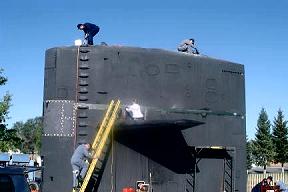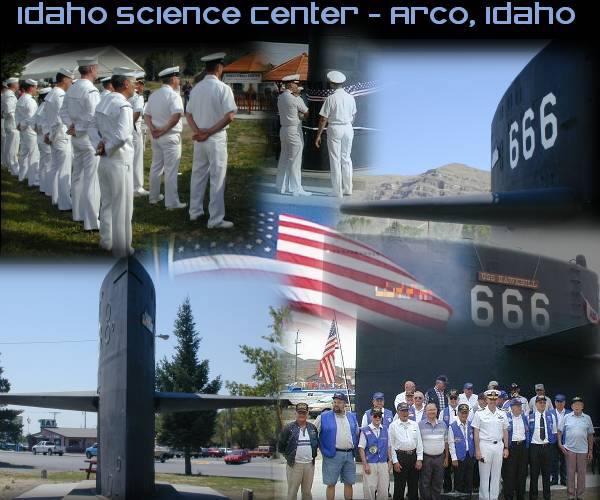
USS Hawkbill Sail Surfaces as Idaho's 'Submarine in the Desert'
Story Number: NNS030724-08
Release Date: 7/24/2003 3:43:00 PM
By Lt. j.g. Penny Cockerell
Naval Information Bureau 1118, Fort Carson, Colo. Public Affiars
ARCO, Idaho (NNS) -- Folks passing through this rural Idaho town of mountains and sagebrush have stopped for months simply to ask: What on earth is a submarine sail doing in the middle of the desert?
After more than two years of preparations, the explanation came when the tall sail, or conning tower, of USS Hawkbill (SSN 666) was officially dedicated to Arco during its Atomic Days celebration July 19.
On hand were some two dozen Reservists from the Pocatello Naval Reserve Center, many of whom spent the last year and a half laying the foundation, putting down conduits for lighting and welding the sail in place.
It was no small task establishing Hawkbill's sail as the only known Submarine in the Desert. But because of Arcos history in nuclear power development, town enthusiasts latched onto the idea, and when Hawkbill was decommissioned in 2001, the Naval Historical Society donated it to them.
Arco, with a population of 1,023, was the site where nuclear propulsion for submarines began. During the Cold War, all of southeast Idaho was a hotbed of nuclear testing and advancements but because their studies were classified, no one knew about it.
Over the last several decades, some 40,000 Sailors trained in nuclear operations at three prototype nuclear power plants in the Arco region.
The very first submarine prototype was in Idaho, so southeast Idaho has a very big connection to nuclear power, said Lt. Robert D. Boston, a Reserve engineering officer who helped install Hawkbill in Arco, where the future Idaho Science Center will be built. Boston drills at the Naval Reserve Center Pocatello under the Naval Reserve Readiness Command Northwest in Everett, Wash.
Once the sail was donated, the next step was moving Hawkbill some 1,000 miles from the sea to the high desert. The move was laborious, but made easier when a group of truck drivers agreed to transport the sail in three parts for just the cost of gasoline.
 The project hit a glitch when state troopers spotted the massive tonnage moving down the highway on three separate trucks and deemed it too dangerous to continue. Undaunted, Hawkbill backers contacted Sen. Larry Craig (R-Idaho) to assist in steering the sail through.
The project hit a glitch when state troopers spotted the massive tonnage moving down the highway on three separate trucks and deemed it too dangerous to continue. Undaunted, Hawkbill backers contacted Sen. Larry Craig (R-Idaho) to assist in steering the sail through.
And as it sailed into town, Mayor Jacques Marcotte of Arco stood high on its top, saluting onlookers like Captain Courageous, one spectator said.
The Department of Energy and Idahos tourism office then donated $6,000 to hire a crane for a day to put the sail in place. Some 15 volunteers, including six welders many of them Reservists scrambled to get the job done in such a short time.
Boston put a pencil to the cost of labor and figured the Reservists saved about $50,000 by donating their drill weekends to install the sail in its permanent place.
The Naval Reserve's contribution has already paid dividends in bringing a symbol of pride to the region.
Hawkbills illustrious history was recounted at the dedication by its last commanding officer, Capt. Robert Perry, who with some emotion, told of its 29 years of missions. To his side stood an American flag that once flew from the decommissioned sub.
I estimate that Hawkbill steamed almost 1.5 million miles, Perry said. Most of what Hawkbill did on her deployments remains classified to this day, but I can guarantee you that Hawkbills crews significantly contributed to our countrys victory in the Cold War.
Hawkbill had the unfortunate chronological numbering of 666, earning it the nickname of Devil Boat. But the ominous biblical numeral never affected its many missions.
 The submarine deployed 10 times to the Pacific and six times to the Arctic Ocean, where it joined the National Science Foundation in several crucial studies at the North Pole. Perry described using the sail as a battering ram to break through three feet of ice a dramatic event that the crew found both jarring and exciting.
The submarine deployed 10 times to the Pacific and six times to the Arctic Ocean, where it joined the National Science Foundation in several crucial studies at the North Pole. Perry described using the sail as a battering ram to break through three feet of ice a dramatic event that the crew found both jarring and exciting.
The Hawkbills significance was not lost on those now responsible for it. Among the attendees were more than a dozen members of the U.S. Submarine Veterans-Hawkbill Base. Eight of their members were World War II veterans. They all wore submarine ball caps and blue vests with the names of their tours stitched on the back.
Now entrusted with Hawkbill, Arco town leaders plan to make it the cornerstone to their future museum, which will highlight nuclear advancements during and after the Cold War.
|


